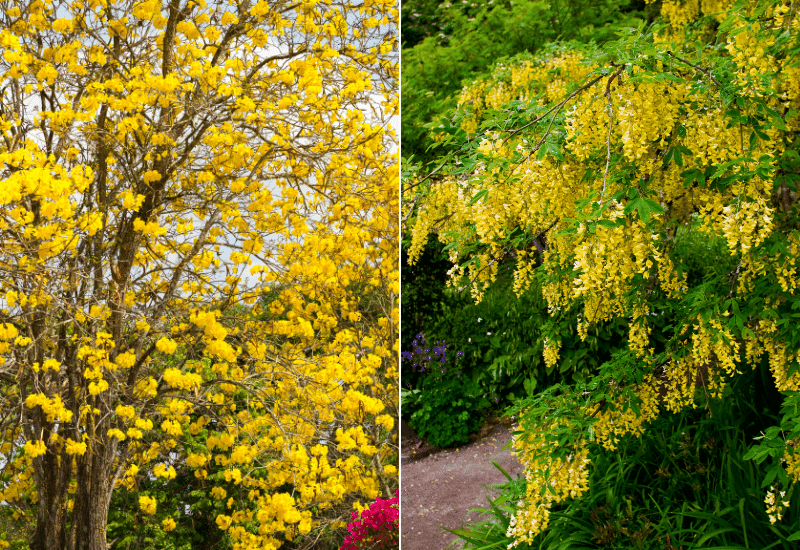
Yellow is the color of energy, of light, of the Sun and also of the flowers of some trees. Positive energy and vibrancy can come to your garden if you grow one of the beautiful varieties of ornamental trees with yellow flowers we have found for you. They will bring light with their sunny and radiant colors far above ground level, thanks to the high branches and crowns of these trees.
There are also some shrubs you can train to be small trees, and finally, some even have a beautiful fragrance, while others attract bees, birds and butterflies.
So, without further ado, let’s see the best yellow blooming trees you can grow in your yard for a bright and cheerful floral display!
So, put your glasses on now, because you are going to see all these trees and their bright blooms right now!
12 Beautiful Trees with Bright Yellow Flowers
Trees with yellow flowers bring a bright note to the garden and cheer us up when the weather is gloomy. To enjoy brightness of yellow blooms that attract all eyes in any season, the good idea is to plant different species of trees with bright and golden blooms.
All the trees you are going to meet in this article have the energetic color of the Sun in their blooms, and here they are.
1: Golden Trumpet Tree (Tablebuia chrystotricha and Tablebuia umbellata)
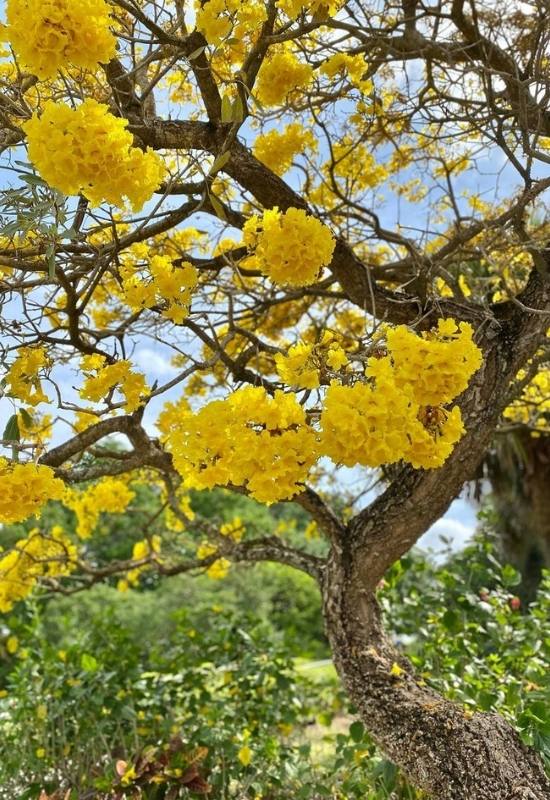
Golden trumpet tree refers to two Brazilian and South American species of Tablebuia with very showy yellow flowers.
Growing fairly fast with a straight and upright trunk, it will form a lovely spreading crown that fills with showy, golden and, of course, trumpet shaped blooms when the branches are still naked in most regions, though the fuzzy silver green leaves may stay on in winter, because it is semi evergreen.
While it is an exotic plant, it is tolerant to temperate regions, where it can bring lots of energy and light. While it is not yet popular in nurseries, it is becoming more and more available, and you may want to be one of the first to have this sunny and unusual tree in your garden.
Do trim lateral shoots when it is young, to make sure that you golden trumpet tree keeps an upright habit, and, despite it being a newcomer to landscaping trees, it is fairly easy to grow.
2: Yellow Flame Tree (Peltophorum pterodarpum)
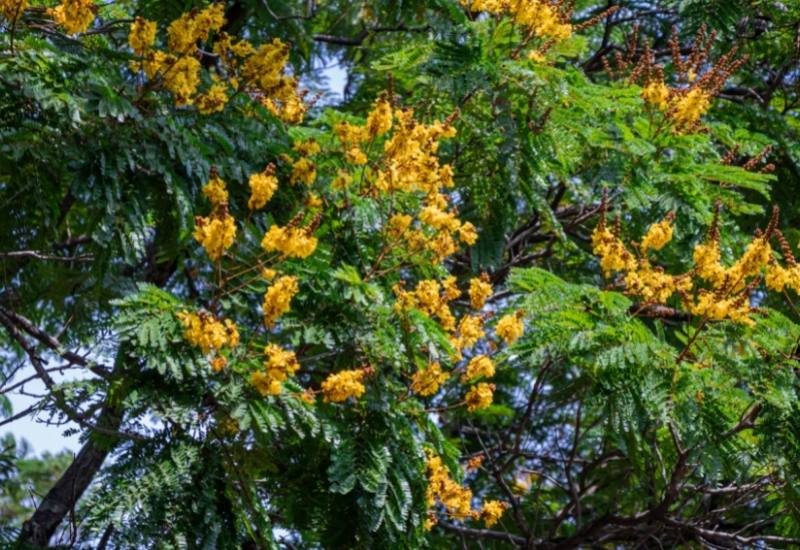
Also known as “copperpod”, yellow flame tree is a great asset for any garden thanks to its blooms, foliage and balanced, harmonic shape.
The golden flowers come in rich clusters at the rips of the branches, dotting it with spots of sunny energy, each being about 1.5 inches across (4.0 cm).
The dark green foliage is very thick but also very fine in texture, thanks to the many leaflets that make up each leaf, making it look like a fresh and soft frond.
It will attract pollinators when in blossom, and then you will get red seed pods, about 4 inches long (10 cm) that turn brown when they ripen.
This ornamental tree with yellow flowers has been grown in Indian gardens for a long time, and it is now becoming popular in the USA as well, especially in Florida. As an extra bonus, it will fix nitrogen into the soil, making your garden more fertile!
3: Cornelian Cherry (Cornus mas)
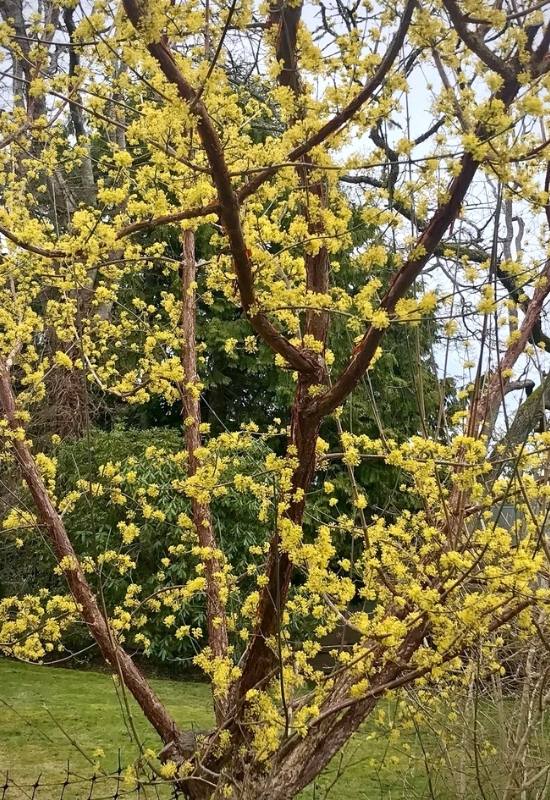
Suitable to temperate climates, Cornelian cherry is a shrub or small tree that fills with yellow blooms every spring. The flowers are small with lime green yellow petals but big golden anthers that give you the overall effect.
They grow straight in the branches almost filling the whole tree. Later on, they will turn into decorative dark fruits, which you can also eat or turn into jams and syrups.
Winner of the Cary Award, this also has a dense, green foliage with copper blushes when young, great for shade and for a natural looking garden. It will also attract bees, and pollinators early in the season, and birds later on.
To make sure your Cornelian cherry turns into a small tree, select the strongest and most upright branch to make it into a straight trunk; prune the others and it will soon adapt to this shape.
4: Golden Chain Tree (Laburnum x watereri ‘Vossii’)
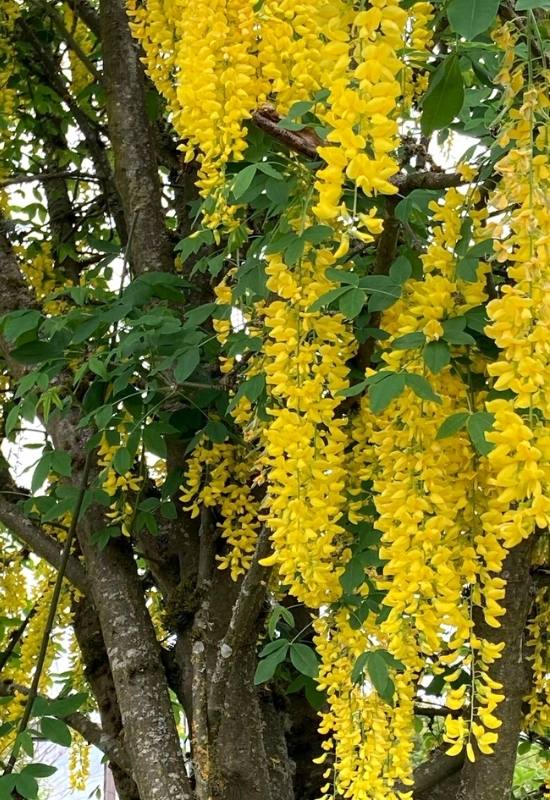
Golden chain is a real spectacle when in bloom! The long dropping clusters of pea like flowers hang down from the branches with their bright yellow color and fragrance.
The effect is like having a yellow wisteria in your garden, also thanks to the abundance and profusion of the blossoms! You can grow it for shade as well, thanks to its dense and glossy mud green foliage.
Each leaf is made up of three leaflets, giving you a fine texture. It will also produce pods which stay in till fall, but do not eat them because they are poisonous.
Its elegant beauty and massive displays has won it the Award of Garden Merit by the Royal Horticultural Society.
Golden chain too can turn into a shrub unless you buy it already formed into a tree or train it by selecting one or two main branches and helping them with a stake when it is young.
Also, make sure you deadhead the spent blooms, because this will encourage a great blossom next year.
5: Cootamundra Wattle (Acacia baileyana ‘Purpurea’)
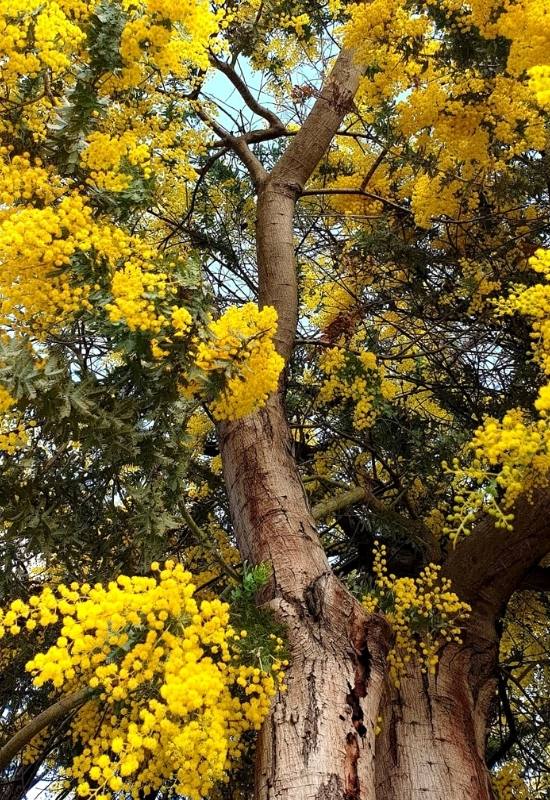
Wattle is a world famous small tree or shrub with mind blowing blooms of yellow, fluffy flowers that cover the whole plant for from winter to spring. There are many varieties you can choose from, but we picked an exceptionally beautiful one for you…
The ‘Purpurea’ cultivar in fact also has a thick canopy of weeping branches with mind blowing foliage.
Thinly textured thanks to the many leaflets, evergreen, it emerges in shades of lavender to purple, and then it becomes sliver blue later in its life!
What an explosion of colors! And, I was forgetting, the blossoms are also very fragrant! It is so valuable in a garden that it has received the Award of Garden Merit by the Royal Horticultural Society.
Ideal for Mediterranean gardens, it will be great in any informal style. Make sure you train it as a tree pruning off the lower horizontal branches when it is young.
6: Blue Paloverde (Parkinsonia florida)
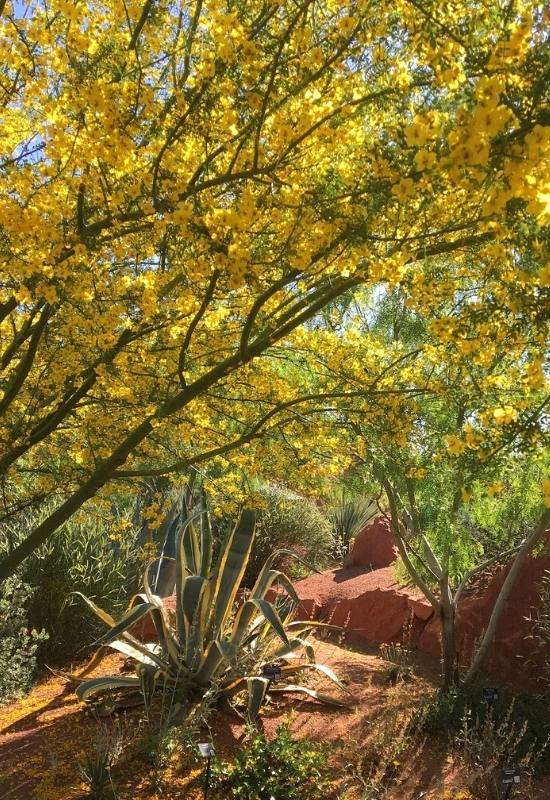
Blue paloverde is like forsythia in tree shape… It fills its branches with saffron yellow blooms in a massive display that lasts from spring to midsummer!
Each flower is large, 2 to 4 inches across (5.0 to 10 cm) and with bright red dots in the central area. The branches are very elegant, arching and they keep green and slender for a long time, spiny and blue green in color, like the trunk.
And then you also get the finely textured foliage of pinnate compound leaves, blue green as well. But this will be absent most of the year, and only crop up when the weather is humid. Finally, the pods of this tree will attract birds to your green space!
Long lived, tough and low maintenance, blue paloverde is a show stopping tree which looks stunning all year round, and it is also the state tree of Arizona.
7: Golden Shower (Cassia fistula)
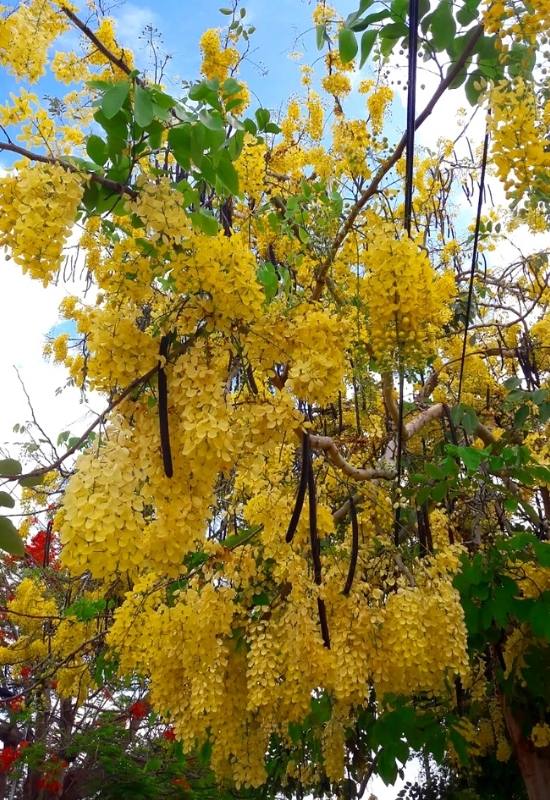
An elegant tree from Southeast Asia, golden shower, also known as Indian laburnum or pudding pipe tree, has drooping clusters of bright yellow and fragrant flowers that hang beautifully from the branches.
Both ornamental and medicinal, this plant is related to peas and beans, and in fact it will also produce pods, but on a massive scale, as they can be 24 inch long (60 cm)!
The foliage is pinnate, bright green and very finely textured, as we find in all Fabaceae. The trunk is slender, often bent and the branches form a lovely fairly open and elegant crown. The flowers and fruits are edible, but these last ones are laxative.
Golden shower is common as a roadside tree, but it will be a great asset in any garden as well, as long as the style is informal, you can even train it to suit a Japanese design. It will also adapt to coastal gardens.
8: Tulip Tree (Liriodendron tulipiferah)
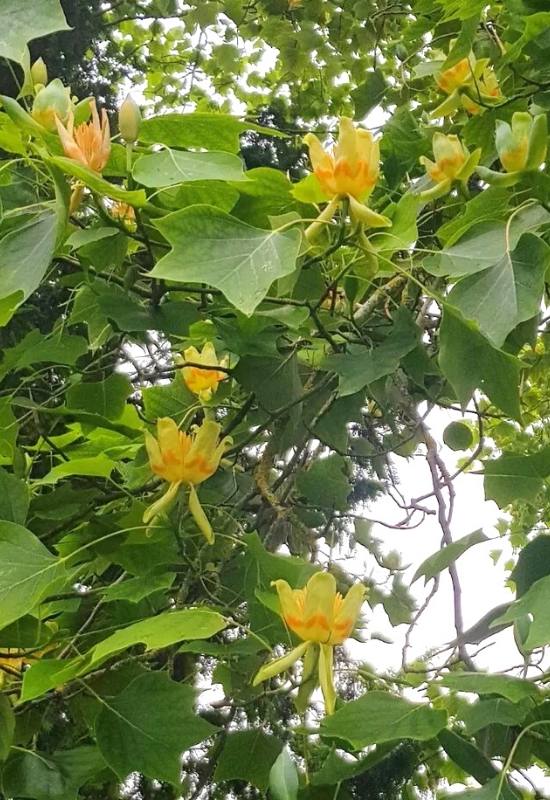
Tulip tree is a stately, tall broad species with showy, exotic looking yellow flowers but it is very suitable to temperate and fairly cold climates.
The name well describes the shape of the blooms, which are cupped and large, about 3 inches across (7.5 cm). These are lime yellow with orange patterns at the base, a huge bulging stamen and saffron pistils.
They look up from the branches that also host glossy, lobed and mid to dark green foliage of large leaves, up to 8 inches long (20 cm).
This forms a very dense canopy which, together with the spreading branches, makes it ideal for shade. It will turn golden in the fall, and the naked branches will give you a final display of come shaped fruits in winter!
Tulip tree is perfect for a bold and even partly exotic presence in a temperate garden; you can really get the best of both world with this yellow flowering tree.
9: California Flannel Bush (Fremontodendron californicum)
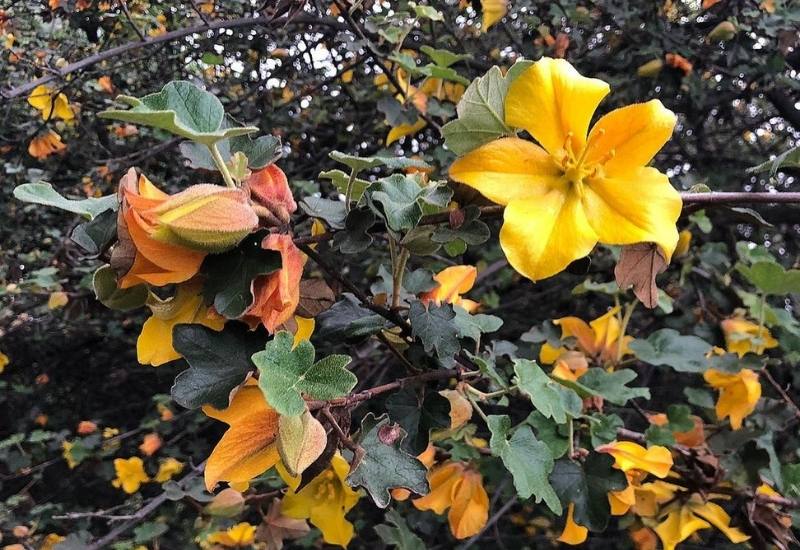
California flannel bush can be both a shrub and small tree, but its showy blooms are always spectacular! The saucer shaped flowers are golden yellow inside, while they have beautiful orange veins on the outside, and bright orange, large anthers.
They are about 3 inches across (7.5 cm) and very abundant on the branches when the foliage is still small and bright green. They will attract butterflies and then turn into capsules with rust colored hairs.
The leaves are lobed and rounded, leathery and dark green, with a felt like hair in the under page; be careful, because these are irritant. But apart from this, you can enjoy the irregular and asymmetrical shape of this plant for many years.
California flannel bush can be trained into a tree by pruning the lower branches when it is young; it is ideal for dry slopes and even rocky hillside gardens.
10: Yellow Weeping Pittosporum (Pittosporum phillyreoides)
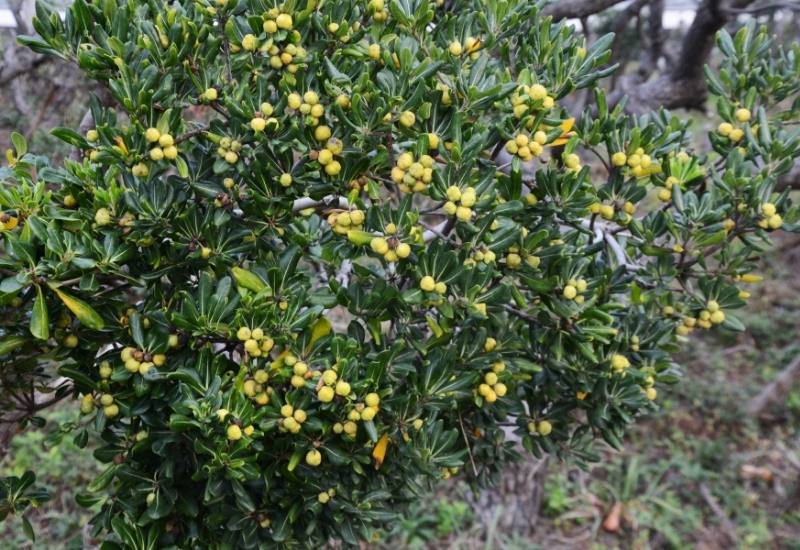
Native of Australia, weeping pittosporum can have white or canary yellow flowers; the choice is yours!
They are small and star shaped, coming in loose dropping clusters that hang elegantly from the branches and they are pleasantly fragrant too!
These, as the name suggests, are weeping, with long, thin and glossy, mid to bright green in color. The fresh, romantic and shady effect of this tree is really fantastic in any garden!
The blooms will then give way to oval and plum like fruits that dangle as they ripen, from green to bright orange later in the season.
These will in turn open revealing a bright red jelly and seeds, and attract birds to feast. They look juicy and they are edible, but very bitter indeed, so add some sugar!
Weeping pittosporum is an eclectic tree, beautiful all year round, with yellow blooms, a beautiful habit, finely textured foliage and showy fruits, it can provide interest to your garden in any season.
11: Yellow Silk Floss Tree (Ceiba speciosa)
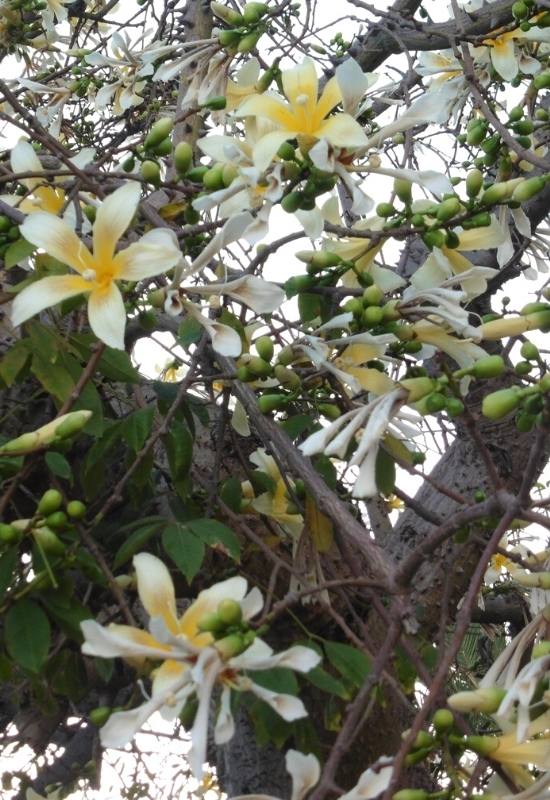
One of the most impressive flowering trees in the whole world also comes with varieties with yellow flowers, silk floss tree.
Its big, lily like blooms can reach 6 inches across (15 cm) and there are in shades of cream yellow, canary, gold and saffron, as well as bicolor ones.
The blossom is generous and a real show stopper, in the late months of the season. This large exotic tree is also famous for the fluffy balls of seeds it produces, hence the name.
But its upright, large and prickled trunk is an element of interest too, as are the green leaves that hang abundantly from the spreading branches. Perfect for shade as well as for its exotic beauty, this South American tree is a real wonder of Nature.
Silk floss tree needs a large and warm garden; your main aim in landscaping will be finding it a central and visible position where you can grow it. Mind your gutters and drains though when the “silk balls” fall, as they can clutter them.
12: Magnolia ‘Hot Flash’ (Magnolia ‘Hot Flash’)
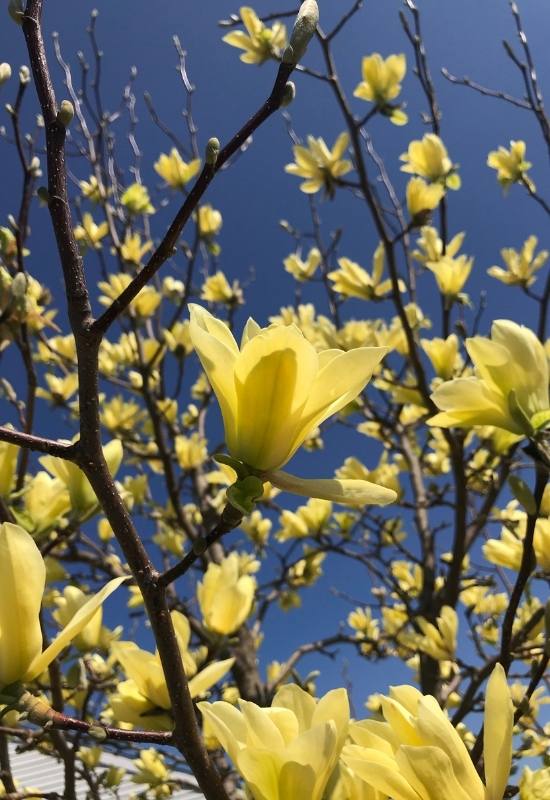
Even magnolias can have yellow flowers, and there are a few varieties that you can choose from, but ‘Hot Flash’ has the most classical look of them all.
While ‘Gold Star’ has thin, very pale yellow petals, ‘Butterflies’ has irregularly arranged pastel yellow petals, the cultivar we have chosen for you has the perfectly cupped shape you expect from a bloom of this tree.
The color is a warm butter to bumblebee hue, which makes it very attractive and soft at the same time. It is also a safe bloomer, because it is a late flowering hybrid of Magnolia ‘Woodsman’ x Magnolia ‘Elizabeth’, so you don’t run the risk of cold damage.
The leaves are glossy, mid green and not leathery like in other varieties. The tree has an upright habit and elegant branches, and it is also perfect for shade.
Magnolia ‘Hot Flash’ is a fast growing tree with yellow flowers, so you can have results in a short time for your garden.
It is suitable to any informal style, also for urban and elegant gardens and, of course, it is one of the few species you can use even in oriental gardens.
Yellow Trees Bring the Energy of the Sun to Your Garden!
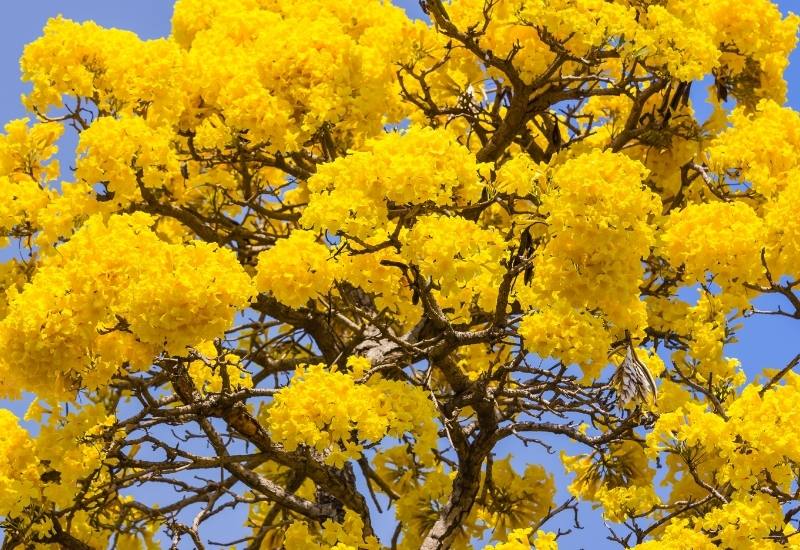
I bet your eyes are shining with light now… With all these beautiful trees with yellow flowers, you have the color and energy of the Sun in them.
And you can also have them in front of you in person if you grow them in your garden. True, many require a warm climate, but there are also some varieties that you can grow in colder regions. But they all share one thing: their energy and beautiful blooms!

Written By
Amber Noyes
Amber Noyes was born and raised in a suburban California town, San Mateo. She holds a master’s degree in horticulture from the University of California as well as a BS in Biology from the University of San Francisco. With experience working on an organic farm, water conservation research, farmers’ markets, and plant nursery, she understands what makes plants thrive and how we can better understand the connection between microclimate and plant health. When she’s not on the land, Amber loves informing people of new ideas/things related to gardening, especially organic gardening, houseplants, and growing plants in a small space.
